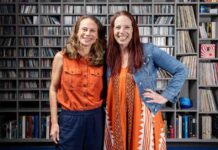It’s a cool autumn morning. It rained during the night. The cobblestone path in Berlin’s Tiergarten is still wet. A thick cloud cover colors the sky grey. We are standing in front of a brown steel gate: It is the entrance to the memorial to the Sinti and Roma of Europe who were murdered under National Socialism. Stefan Pavlovic and his colleague David Nikolic organized a guided tour today on the subject of the persecution and extermination of the Sinti and Roma during the Nazi era. We hear trolley suitcases clacking over cobblestones. A group arrives – about 15 Roma and non-Roma from various Belarusian Roma organizations.
The two students Stefan and David are part of the “Me Sem Me” project, which was launched by the “Rroma Information Center” in Berlin. In the project, young descendants whose families were affected by Nazi persecution report on the genocide of the Roma and Sinti. David says he feels a kind of obligation to his ancestors to bring history closer to others. “Me Sem Me” is Romani and translated into German means: “I am I”. The association wants to make it clear that they want to be accepted as Roma.
This is important for them, because racism against the Sinti and Roma community is still widespread today. Stefan knows this only too well. When he graduated from high school, a teacher accused him of only doing it to keep collecting child support. “I was shocked. That’s why these tours are so important to me. Here we can educate about racism from the start. We often have school groups here as well.”
Today’s group from Belarus came especially to guide the young people – and to get to know the Rroma Information Center. They are only in Berlin for two days. I am not allowed to take photos of the participants. Since Belarus classifies Deutsche Welle as “extremist”, they fear for their state funding.
The memorial is a clearing surrounded by trees, with the Reichstag in the background. In the middle of the clearing is a small lake from which rises a triangular pedestal that rises and falls every day, each time with a fresh little flower on it. Actually it is a harmonious picture, a quiet place of remembrance in the middle of the hectic inner city. But as we enter today, a different picture emerges. Cleaning equipment whirrs and the lake, on whose surface the sky, Reichstag and trees are usually reflected, is empty. The pool is cleaned.
We walk through the wet meadow that surrounds the rest of the monument and stop near some trees whose leaves are already turning yellow. Stefan explains that the monument was designed by Israeli artist Dani Karavan. He was the son of Polish-Jewish immigrants. In the background you can usually hear the violin piece “Mare Manuschenge”, composed by the Sinto musician and politician Romeo Franz.
We approach the empty pool of water and Stefan points to the metal edging that reads: “Sunken face; extinguished eyes; cold lips; Silence; a torn heart; without breath; without words; no tears”. It is a poem entitled “Auschwitz” and comes from the Italian Roma musician and university teacher Santino Spinelli.
The Belarusian group is moved even if the monument is not showing its full effect today due to the cleaning work. A Rom tells me that this is the most important and poignant moment of his life. In Belarus there are also memorials for the victims of National Socialism, but none that are specifically aimed at Sinti and Roma.
Another group member is impressed by the central location between the Reichstag and the Brandenburg Gate. This shows how important Germany is to commemorate. When Stefan then tells them that they are currently afraid of losing the monument due to the planned construction of an S-Bahn tunnel, the group is horrified.
Stefan and David point to the stone slabs on the ground that border the lake. They remind you of shards. On these are the places of the executions, the concentration and extermination camps. Stefan pulls out a tablet and shows a picture of Johann “Rukeli” Trollmann.
The group gathers around him to see something. Trollmann was a German Sinto, a famous boxer. In 1933, as a protest against the Nazi regime’s racial fanaticism, he had his hair dyed blond and his skin powdered white in a boxing match. He was murdered in a satellite camp of the Neuengamme concentration camp in 1944.
The cleaning work on the monument has been completed. As the lake slowly fills up with water again, a few faint rays of sunshine make their way through the dense cloud cover. They are reflected in the lake, which appears deep and black. The Belarusian group quickly takes photos. Then they have to go. Your plane is leaving soon. Stefan and David do the last part of the tour with me alone.
We stop at the “Topography of Terror” memorial site. The cloud cover has closed again. The gray buildings and stone slabs of the place become almost one with the gray of the sky. Stefan explains that the headquarters of the Secret State Police, the SS and the Reich Security Main Office were located here during the Nazi era.
We go down to the exhibition ditch. A long line of information boards, in front of many visitors. We push our way to a board that deals with the persecution of the Sinti and Roma. We see pictures of the camp in Berlin Marzahn. Stefan explains that Roma and Sinti were sent to this camp before the 1936 Berlin Olympics.
The camp was a first stop on the way from systematic exclusion to murder. In 1943, the National Socialists deported almost all inmates to Auschwitz and killed them there.
The Austrian Romni Ceija Stojka is one of the few concentration camp prisoners who survived Auschwitz. As a child she was in three concentration camps. She later became a writer and artist. Stefan ends his tour with a quote from her: “I’m afraid that Europe will forget its past and that Auschwitz is just sleeping.” That’s exactly what Stefan and David want to prevent with the “Me Sem Me” tour.
Autor: Nadine Michollek
The original of this post “I’m afraid that Auschwitz only sleeps” comes from Deutsche Welle.















